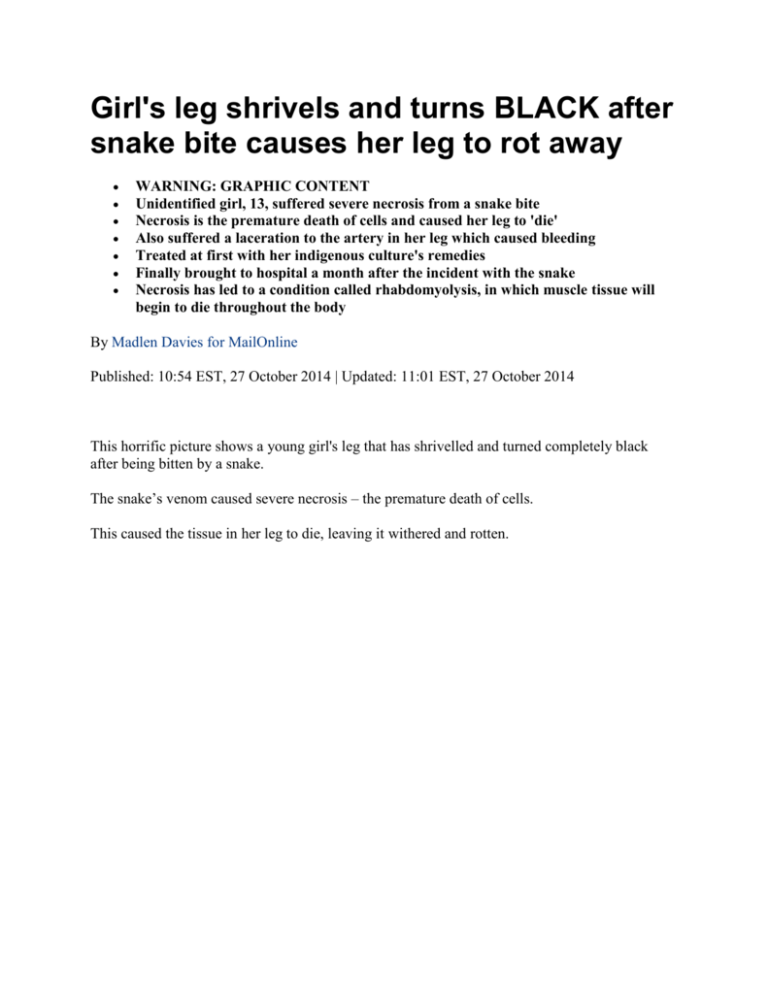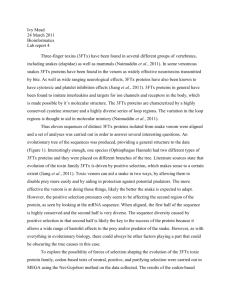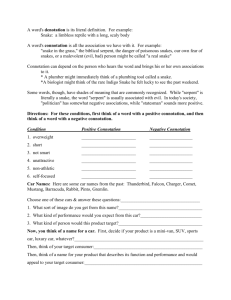Necrosis of girl`s l..
advertisement

Girl's leg shrivels and turns BLACK after snake bite causes her leg to rot away WARNING: GRAPHIC CONTENT Unidentified girl, 13, suffered severe necrosis from a snake bite Necrosis is the premature death of cells and caused her leg to 'die' Also suffered a laceration to the artery in her leg which caused bleeding Treated at first with her indigenous culture's remedies Finally brought to hospital a month after the incident with the snake Necrosis has led to a condition called rhabdomyolysis, in which muscle tissue will begin to die throughout the body By Madlen Davies for MailOnline Published: 10:54 EST, 27 October 2014 | Updated: 11:01 EST, 27 October 2014 This horrific picture shows a young girl's leg that has shrivelled and turned completely black after being bitten by a snake. The snake’s venom caused severe necrosis – the premature death of cells. This caused the tissue in her leg to die, leaving it withered and rotten. The 13 year old girl suffered severe necrosis - the premature death of cells - due to a snake bite that was treated with local indigenous remedies for a month before she was brought to a hospital in Carcaras The 13-year-old girl, who is unidentified, was first treated by remedies from the indigenous culture she was from, according to a photograph posted on Instagram by the username 'juventudmedica'. A month later she was eventually brought to Carcaras, Venezuela,for medical treatment. One doctor, who has seen the photograph, told MailOnline the girl will need her leg amputated but is still likely to die from the snake venom. Dr Arun Ghosh, a private GP in Liverpool, said: ‘Snake venom is very complicated and depends on the species of snake. 'But the picture shows clearly severe tissue necrosis that will need amputation, though she still may die from this due to the nature of the poison. ‘The whole lower leg is black, it’s spreading up. Looking at the rest of her body she’s showing signs of muscle wastage from the poison. Her other leg is thin. It's likely she will still die.' He added that the necrosis has led to a condition called rhabdomyolysis, in which muscle tissue will begin to die throughout the body. Rhabdomyolysis can result in damage to the kidneys, which coupled with low blood pressure, can lead to kidney failure and even death if left untreated, he said. Being treated with local remedies probably meant she was given antibiotics, but not treatment to adequately control poisoning from the snake venom, which contains agents that paralyse the nerves and cause the blood to clot. Snake venom, such as from the bothrops viper common in Venezuela, contains agents that paralyse the nerves and cause the blood to clot so the snake can paralyse its prey Dr Ghosh said: ‘This girl has had classic rural treatment which is often only able to treat local infection secondary to the bite (at best say equal to antibiotics). 'But she is unlikely to have received anti-venom treatment (which entails giving treatment to stop blood clotting) to keep her blood flowing through her body.’ The photograph’s caption said the girl also suffered a broken elbow from the incident with the snake. The bite caused a laceration to the artery in her leg and the resulting bleeding led to what's known as ‘compartment syndrome'. This is a serious condition when pressure within a compartment such as the leg causes a decrease in blood supply to the affected muscles.








